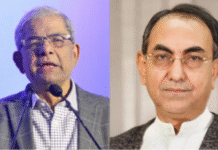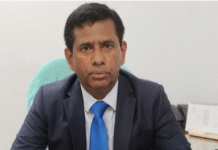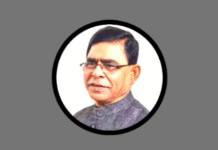The Daily Star

Despite a steady dip in infection and death rates over the last three weeks, experts fear another wave of Covid-19 might be around the corner and say there is no room for complacency.
Their fear is rooted in the lowering of guard by the authorities and general public alike amid an improving coronavirus situation.
It also stems from how things are changing in neighbouring India where a panel of health analysts see a third wave coming any time between September and October.
Since the pandemic hit these shores in March last year, Bangladesh has witnessed a pattern of infection and deaths similar to that in India.
Against this backdrop, health officials in Bangladesh have urged people to strictly maintain health guidelines while participating in economic activities, which are returning to pre-pandemic levels.
Experts said the infection and death rates are still above the danger level and the withdrawal of restrictions on all economic and social activities, except education institutions, may fuel another spike.
The infection rate on August 31 was 11.95 percent. It was 29.97 percent on August 1, according to the DGHS data. An infection rate above five percent is widely considered to be in the danger level.
If there are no Covid-19 cases and deaths for two to three weeks, then it can be said the situation is under control, according to the DGHS.
“There is no room for complacency since the infection and death rates are still high. As all economic activities are open and people are not caring much about maintaining heath guidelines, the country might face another wave,” Dr Mushtuq Husain, an adviser to the Institute of Epidemiology Disease Control and Research (IEDCR), told The Daily Star on Tuesday.
Experts also think the government should utilise the improving situation to plug the loopholes in healthcare facilities and so become adequately prepared for a possible third wave. They also suggested that the government ramp up vaccination, which is key to curbing deaths and hospitalisations.
Only around four percent of the country’s population of over 160 million have so far received both doses of Covid-19 vaccine.
Talking to The Daily Star recently, Abul Bashar Mohammed Khurshid Alam, director general of Directorate General of Health Services (DGHS), said, “We are keeping an eye on the neighbouring country [India] and also the Covid situation across the world.
“We will act in accordance with the situation. But again, if we fail to maintain health guidelines, things will turn grave in no time.”
Experts blame the Delta variant, first detected in India, for the second wave that has so far claimed around 10,000 lives in Bangladesh.
In India, a panel of experts in a report submitted to the country’s Prime Minister’s Office predicted three scenarios: the third wave could peak in October with 3.2 lakh positive cases per day; five lakh positive cases per day; and two lakh positive cases per day.
After infections and deaths peaked in India in late April and early May, when daily infections shot to 4 lakh, it started declining gradually.
India, a country of over 1.36 billion people, recorded 25,000 new cases on August 22. But daily cases have risen to over 40,000 since then.
Kerala’s weekly positivity rate is around 14-19 percent, which impacted the neighbouring states, according to an NDTV report yesterday.
The third wave will be driven mostly due to mutations of the virus, reported Indian media quoting government experts.
Experts are already looking at the Kappa variant, which was designated a Variant of Interest in April 2021 by the WHO.
Another variant causing concerns is the new Delta plus variant, which is considered highly infectious and has been reported in Maharashtra, Indian media reported, adding that experts have warned that this variant may trigger a third wave of the pandemic in the state.
Besides, the spectre of children being affected in a possible third wave is also rising.
“During the first wave, Covid attacked mainly the elderly and spared the youngsters — the second wave is attacking a large number of young breadwinners. The third wave is likely to attack children, since most adults are already infected or immunised,” Dr Devi Shetty, a cardiac surgeon and head of Karnataka’s Covid-19 task force, wrote in an editorial in the Times of India on May 12.
Bangladesh’s Covid-19 situation improved significantly early this year as daily infection rates came down to around two percent, but from March it started shooting up again.
Since the first case of the Delta variant was detected in India on May 8, the situation went downhill fast.
Due to the dominance of the Delta variant, Bangladesh witnessed record daily infection and death rates. June and July were the worst months.
THINGS THE GOVT SHOULD DO
Former DGHS director (disease control) Dr Be-Nazir Ahmed suggested that the government immediately conduct a serosurveillance in different areas to understand the real Covid-19 situation.
Serosurveillance provides estimates of antibody levels against infectious diseases and is considered the gold standard for measuring population immunity due to past infection or vaccination, according to National Centre for Immunisation Research and Surveillance (NCIRS).
“This will help the government make a scientific projection and also plan effective measures to contain the probable third wave.”
Ahmed also suggested that as the situation is improving, the government should identify the weak links in the chain of treatment facilities and address those immediately.
“In the new normal situation, the government should launch a massive campaign to encourage mask-wearing and frequent hand washing. At the same time, we have to expedite the vaccination campaign,” said Ahmed.
Health officials said they were trying to appoint more healthcare professionals in the shortest possible time to improve healthcare services at the district level to counter any upcoming surge.
DGHS DG Khurshid Alam said 401 anaesthetists have already been appointed and they will be sent to district hospitals soon.
“Around 4,000 doctors will be recruited soon through the 42nd BCS [Bangladesh Civil Service] exam. Recruitment of technologists is also under process.”
He added, “We have got time as the pressure on hospitals has recently decreased. So, now we will complete setting up ICU and HDU facilities in district hospitals that lack those. By the end of September, we will get 40 oxygen generators and those too will soon be installed.”
The DG, however, said greater focus should be placed on prevention rather than on treatment facilities, given that resources are limited and already overstretched.
“We cannot increase the healthcare facilities overnight. Even if we expand healthcare facilities, is it possible to increase healthcare professionals? So, we have to keep focusing on prevention,” said Alam.


 For all latest news, follow The Daily Star’s Google News channel.
For all latest news, follow The Daily Star’s Google News channel. 







